Battling with the Africanized Bees
My struggle with what has been called the most successful biologically invasive species ever to plague the western hemisphere.
By Jack Ewing
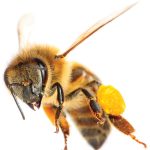 Hacienda Barú Lodge has been in operation since 1990, and I thought that I had experienced all of the problems that could possibly confront a hotel manager. That was until one warm March evening in 2012 when a swarm of africanized bees invaded one of our guest rooms. The guests had returned to their room about 6:30 pm and found it full of bees. The first hotel employee they encountered was the guard who they told about the problem. He went to see for himself and called the office on his radio.
Hacienda Barú Lodge has been in operation since 1990, and I thought that I had experienced all of the problems that could possibly confront a hotel manager. That was until one warm March evening in 2012 when a swarm of africanized bees invaded one of our guest rooms. The guests had returned to their room about 6:30 pm and found it full of bees. The first hotel employee they encountered was the guard who they told about the problem. He went to see for himself and called the office on his radio.
“There are a lot of bees in #24” he told me.
“How many is a lot?” I asked, “10, 20, 50?”
“Oh no, lots more; I mean that there are 1000’s of bees in #24.”
“I’ll be right there,” I said, and headed out the door.
When I walked into the room I couldn’t believe my eyes. Hanging from a wall lamp directly above the bed was an elongated mass of bees shaped kind of like an American football, but twice as big. The guard hadn’t exaggerated. There were literally 1000’s of bees clinging together in one bunch and others flying around the room. I knew enough about their life cycle to know that the new queen was at the center of that mass which is, more correctly, called a swarm. Their intention was to create a hive in room #24. I, of course, was determined not to let that happen.
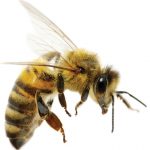 Fortunately the swarm was calm, probably because of the late hour. I knew that the fire department was usually available to deal with problems with bees, but they would have to come all the way from Quepos. I also knew that they spray soapy water on the hive or swarm. Apparently the soap sticks to the bee’s wings and immediately incapacitates them. I found a sprayer with a two-gallon tank, dumped in a double handful of laundry detergent filled it with water, and shook it up. Back at the room I began spraying the soapy water in the air and directly on the swarm. Flying bees fell to the floor where they fluttered around and eventually died. Bees peeled off the swarm and also fell to the floor. I had to refill the sprayer once, but finally the oblong mass was gone and 1000’s of dead and dying bees were all over the floor. After closing the office at 7:00 pm my assistant, Shirley, came to help. We swept up a small waste basket full of bees and swept all the water out the door. Had we had another room available I would have relocated the guests, but we were fully booked. They were very understanding and said they didn’t mind sleeping in the same room. All the bees were gone. We cleaned it the best we could and changed the bedding. Fortunately I had covered the bed with plastic before starting to spray. I gave a big sigh of relief. Problem solved.
Fortunately the swarm was calm, probably because of the late hour. I knew that the fire department was usually available to deal with problems with bees, but they would have to come all the way from Quepos. I also knew that they spray soapy water on the hive or swarm. Apparently the soap sticks to the bee’s wings and immediately incapacitates them. I found a sprayer with a two-gallon tank, dumped in a double handful of laundry detergent filled it with water, and shook it up. Back at the room I began spraying the soapy water in the air and directly on the swarm. Flying bees fell to the floor where they fluttered around and eventually died. Bees peeled off the swarm and also fell to the floor. I had to refill the sprayer once, but finally the oblong mass was gone and 1000’s of dead and dying bees were all over the floor. After closing the office at 7:00 pm my assistant, Shirley, came to help. We swept up a small waste basket full of bees and swept all the water out the door. Had we had another room available I would have relocated the guests, but we were fully booked. They were very understanding and said they didn’t mind sleeping in the same room. All the bees were gone. We cleaned it the best we could and changed the bedding. Fortunately I had covered the bed with plastic before starting to spray. I gave a big sigh of relief. Problem solved.
Or so I thought. The next morning there were bees in rooms #22, 23, 24, 25, and #26 but less than a dozen in each room. They weren’t aggressive and seemed disoriented, but there were enough of them to upset the guests. We continued spraying the soapy water inside and outside of the rooms with the same results, the bees died, and later in the day or the following day the rooms had bees inside of them again and others hanging around outside. We couldn’t understand where they were getting into the rooms which had always appeared to be mosquito proof. We tried sealing every tiny little crack or opening where a bee might squeeze through. But the bees kept returning on a daily basis. Eventually, as the rainy season settled in, the bees quite coming. I was elated, but cautious. I doubted that this was the end of the story.
As it turned out it was the end of the story for that year. The following dry season, a year later, the bees were back. I consulted with the fire department in Quepos and learned that there was probably a large hive in the area, which the fireman referred to as a “mother hive”. In February or March every year the larger hives produce a new queen which leaves the hive with a large group of worker bees. These are referred to as a swarm, and their purpose is to start a new hive. That’s what happened in room #24 a year earlier. After we killed the queen that first night the remaining workers stayed in the area, but having no hive or queen to defend their aggressiveness was gone. The problem was that the first night, when the bees swarmed in room #24, they left an odor in the room that is undetectable to humans but will continue to attract bees for years. Unfortunately, he didn’t have any recommendations on how to deal with it.
Knowing all of that didn’t help us solve the problem at hand. I told Olman, our maintenance man, to check with the house cleaning crew every day at mid morning and, if there were any bees, to deal with them. After a couple of weeks I realized that we hadn’t received any guest complaints about bees for four or five days. I checked with house cleaning who informed me that they hadn’t seen any. I was puzzled by the situation. The year before the problem had persisted into June, and we were only in February. One day I made a comment to Olman, about how odd it was that the bees had left so suddenly. “Nothing odd about it,” exclaimed Olman. “You told me to deal with the problem, so I did. I know you don’t like pesticides, and neither do I, but this situation was serious. Soapy water wasn’t doing the trick. One day when I was in the farm supply store I asked the clerk if they had a pesticide that would kill bees, and explained our problem to him. He sold me a product, and told me to spray it on the outside of the rooms. ‘It will get rid of your bees,’ he told me. So that’s what I have been doing. Once a week I spray the outside walls of the rooms, and the bees don’t come around anymore.” During my 46 years in Costa Rica I have come to admire the intelligence and problem solving ability of campesinos, and this served to strengthen that respect. It was a great example of the simplest solution being the best; if what you are doing doesn’t work, do something else.
Our experience with what biologists call africanized bees began years earlier. During the 1950’s some scientists in Brazil imported a number of bees from an extremely aggressive African species in the hopes of increasing honey production in Brazil. The problem began when 26 swarms escaped into the wild in 1957. They crossed with local bees thus producing hybrid bees that were more aggressive than the local bees and less aggressive than the African bees. By the time they reached Costa Rica, in the mid 1980s they were considerably less aggressive than the original African species, but considerably more aggressive than our local honey bees. Africanized bees have a larger defensive area around the hive, react more quickly to any perceived threat, react in larger numbers, and chase the victim farther. Over 1000 humans and many farm animals in the Americas have been killed by them.
The US Department of Agriculture was concerned that the africanized bees would migrate as far as the United States. They decided to try and stop them in Costa Rica, the narrowest point in the Central American isthmus. They trained a group Costa Rican Ministry of Agriculture (MAG) employees as well as the fire departments to combat them and provided the necessary resources for salaries, vehicles, and equipment. For a couple of months in 1984 MAG employees as well as USDA personnel were a common sight. They dealt with several hives on Hacienda Baru. They used diesel rather than soapy water. It worked well but quickly destroyed the rubber seals in our sprayers. One day the USDA received the message that the bees had been reported in El Salvador. In 1985 they appeared in the San Joaquin Valley in southern California. In Costa Rica the africanized bees have taken over completely. There are no more of the original local honey bees left here. (On an interesting side note: most of the local honey bees had originally been of an Italian species which had been selectively bred for honey production and their gentle disposition.)
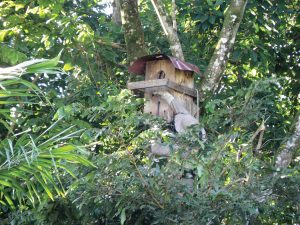
Beginning in January of 2014 scarlet macaws began visiting Hacienda Baru and the surrounding area on a regular basis. In mid-July of that year the macaws’ behavior suggested that they might be scouting out nesting sites. We decided to put up nesting boxes in four trees that the big red birds frequented and see if we could help them out with their endeavor. Many types of boxes are described on Internet, but we chose one made of wood and measuring 35 cm x 35 cm x 70 cm. All were mounted about 25 meters above the ground. We waited for the macaws to move in, but that never happened. They never went near the boxes. We thought that maybe parrots or parakeets would use them, but no such luck. The boxes just hung there, empty, we thought.
In February of this year one of our guides focused his telescope on the entrance hole to a nesting box to see if anything at all was inside. What he saw astounded everyone. The box was full of bees. No wonder the macaws weren’t interested in them, and even stopped visiting the trees where they hung. A quick check confirmed that all four boxes contained active hives of bees. With that many hives in such a small area they would all be competing for locations suitable for new hives and could be expected to invade any natural cavity including houses and hotel rooms.
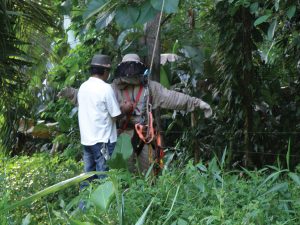
Again we were faced with a bee problem, a much bigger one complicated by the fact that the hives were located 25 meters above the ground. I decided to go to Quepos and talk to firemen. I learned that they had no means of dealing with a hive that far off the ground. I explained that we had three guides who frequently guide people into the tree tops on a tour we call Tree Climbing. Any of them could easily climb up to the hives. We discussed several different plans, and consulted with the guides who would have to carry them out. In the end the fire department lent us a protective suit which one of the guides could wear while climbing up to the box. The climber could carry a two-gallon sprayer with a strong pesticide that would kill the bees instantly. Once the bees were all dead the box could be dropped to the ground. The fire department preferred that we use soapy water, but I decided on the faster acting pesticide out of concern for the climber’s safety.
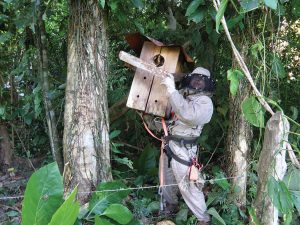
It went like clock work. Carlos and Pedro first put a rope over a branch near the first hive. Carlos then put on the suit, hung the sprayer over his shoulder and a small wrench from his belt, and began the long climb. The suit was hot even though it was 6:30 am. There were a few bees flying around the outside of the hive which attacked him a couple of meters before he reached the box. He sprayed them and quickly climbed the last few steps. Once close to the box he stuck the nozzle through the four-inch hole and sprayed the inside. All of the activity around the hive quickly diminished and then ceased. All the bees, including the queen, were dead. Finally he removed the cable clamps and let the box drop to the ground, later to be burned.
We had limit our activity to one hive per day, early in the morning. As the sun climbed higher in the sky and began to warm things up the bees became much more aggressive and attacked the men on the ground while they were trying to get the rope in the tree. Carlos did the first two trees, Ronald did the third, and Carlos did the last one.

We are very grateful to the Quepos Fire Department for all of the help they have given us. They are true professionals and very willing to help the public. Thank you guys.
As I write these words Carlos has just finished with the last box. We have won another battle against the africanized bees, but somehow I don’t think the war is over. We will just have to wait and see.

